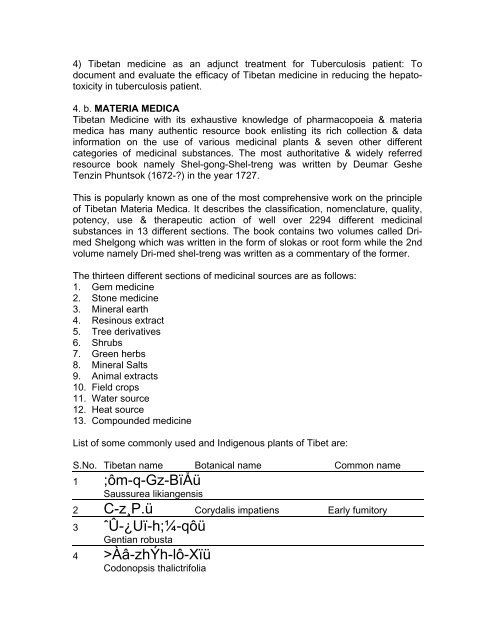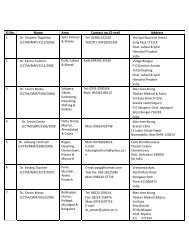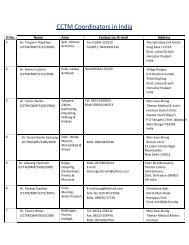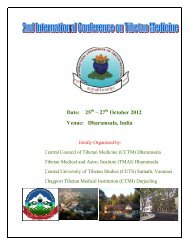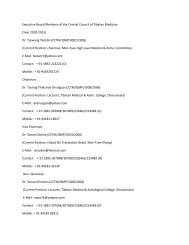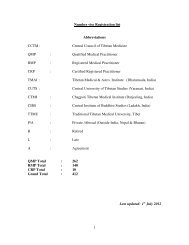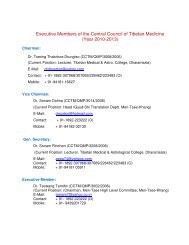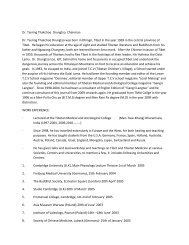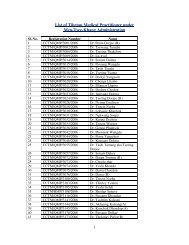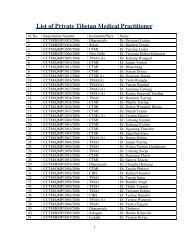1. The Central Council of Tibetan Medicine (CCTM) The Central ...
1. The Central Council of Tibetan Medicine (CCTM) The Central ...
1. The Central Council of Tibetan Medicine (CCTM) The Central ...
You also want an ePaper? Increase the reach of your titles
YUMPU automatically turns print PDFs into web optimized ePapers that Google loves.
4) <strong>Tibetan</strong> medicine as an adjunct treatment for Tuberculosis patient: To<br />
document and evaluate the efficacy <strong>of</strong> <strong>Tibetan</strong> medicine in reducing the hepatotoxicity<br />
in tuberculosis patient.<br />
4. b. MATERIA MEDICA<br />
<strong>Tibetan</strong> <strong>Medicine</strong> with its exhaustive knowledge <strong>of</strong> pharmacopoeia & materia<br />
medica has many authentic resource book enlisting its rich collection & data<br />
information on the use <strong>of</strong> various medicinal plants & seven other different<br />
categories <strong>of</strong> medicinal substances. <strong>The</strong> most authoritative & widely referred<br />
resource book namely Shel-gong-Shel-treng was written by Deumar Geshe<br />
Tenzin Phuntsok (1672-?) in the year 1727.<br />
This is popularly known as one <strong>of</strong> the most comprehensive work on the principle<br />
<strong>of</strong> <strong>Tibetan</strong> Materia Medica. It describes the classification, nomenclature, quality,<br />
potency, use & therapeutic action <strong>of</strong> well over 2294 different medicinal<br />
substances in 13 different sections. <strong>The</strong> book contains two volumes called Drimed<br />
Shelgong which was written in the form <strong>of</strong> slokas or root form while the 2nd<br />
volume namely Dri-med shel-treng was written as a commentary <strong>of</strong> the former.<br />
<strong>The</strong> thirteen different sections <strong>of</strong> medicinal sources are as follows:<br />
<strong>1.</strong> Gem medicine<br />
2. Stone medicine<br />
3. Mineral earth<br />
4. Resinous extract<br />
5. Tree derivatives<br />
6. Shrubs<br />
7. Green herbs<br />
8. Mineral Salts<br />
9. Animal extracts<br />
10. Field crops<br />
1<strong>1.</strong> Water source<br />
12. Heat source<br />
13. Compounded medicine<br />
List <strong>of</strong> some commonly used and Indigenous plants <strong>of</strong> Tibet are:<br />
S.No. <strong>Tibetan</strong> name Botanical name Common name<br />
1 ;ôm-q-Gz-BïÅü<br />
Saussurea likiangensis<br />
2 C-z¸P.ü Corydalis impatiens Early fumitory<br />
3 ˆÛ-¿Uï-h;¼-qôü<br />
Gentian robusta<br />
4 >Àâ-zhÝh-lô-Xïü<br />
Codonopsis thalictrifolia


